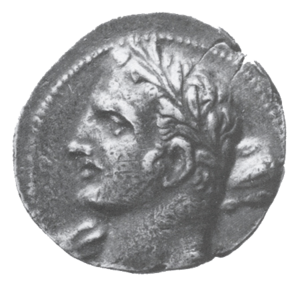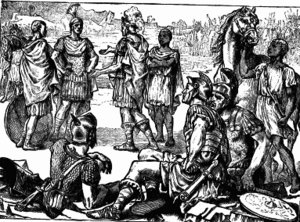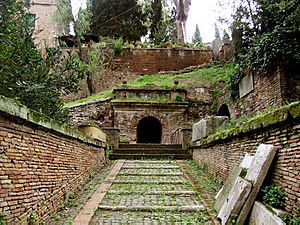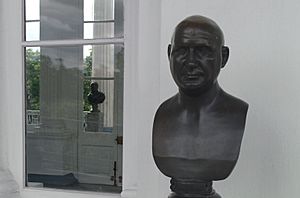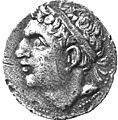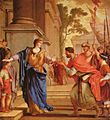Scipio Africanus facts for kids
Quick facts for kids Publius Cornelius Scipio Africanus |
|
|---|---|
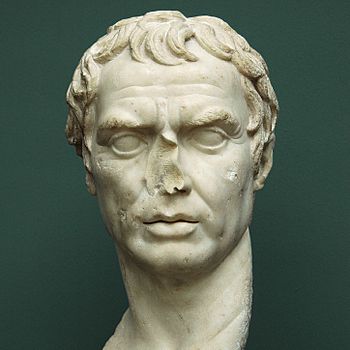
Bust likely of Scipio Africanus (formerly identified as Sulla), originally found near his family tomb
|
|
| Consul of the Roman Republic | |
| In office 194 BC served with Ti. Sempronius Longus |
|
| In office 205 BC served with P. Licinius Crassus Dives |
|
| Proconsul of the Roman Republic | |
| In office 210 BC |
|
| Personal details | |
| Born | 236 or 235 BC Rome, Italy, Roman Republic |
| Died | 183 BC (aged 52–53) Liternum, Italy, Roman Republic |
| Nationality | Roman |
| Children | 4, including Cornelia |
| Relatives | Scipio Asiaticus (brother) Scipio Aemilianus (adoptive grandson) Tiberius and Gaius Gracchus (grandsons) |
| Known for | Defeating Hannibal |
| Awards | Triumph |
| Military service | |
| Allegiance | Rome |
| Service/branch | Roman army |
| Battles/wars |
|
Publius Cornelius Scipio Africanus (born around 236/235 BC, died 183 BC) was a famous Roman general and leader. He is best known for helping Rome win against Carthage in the Second Punic War. Many people think he was one of the greatest military commanders ever. His biggest success was defeating Hannibal at the Battle of Zama in 202 BC. This victory in Africa earned him the special name Africanus, which means "the African" or "conqueror of Africa."
Scipio also conquered parts of Spain that belonged to Carthage. He was seen as a hero by the Roman people. But he also had many rivals, like Cato the Elder, who did not like him. Later in his life, Scipio faced some unfair accusations. He decided to leave Rome and live a quiet life at his home in Liternum.
Contents
Scipio's Early Life
Publius Cornelius Scipio was born into a very important Roman family called the Cornelii Scipiones. He was born around 236 or 235 BC. His family was one of the main noble families in Rome. They had a long history of serving in high government jobs since the early days of the Roman Republic.
Scipio's great-grandfather and grandfather had both been consuls and censors. His father, also named Publius Cornelius Scipio, was a consul in 218 BC. His mother was Pomponia.
Scipio was also a member of the Salii, a group of priests who served the god Mars.
Early Military Experience
Scipio joined the Roman army when the Second Punic War against Carthage began. This was in the same year his father was a consul. During the Battle of Ticinus, Scipio bravely saved his father's life. He charged alone into the enemy forces to protect him.
He also survived the terrible defeat at the Battle of Cannae. In this battle, his future father-in-law, Lucius Aemilius Paullus, was killed. After the battle, Scipio and another officer took charge of the surviving soldiers. When some young nobles wanted to leave Rome, Scipio stopped them. He made them promise they would not abandon their city.
In 213 BC, Scipio wanted to become an aedile, a Roman official. He was too young for the job by law. But because he was already known for his bravery, the people elected him anyway. Everyone voted for him, and the officials who had objected gave up.
Winning in Spain
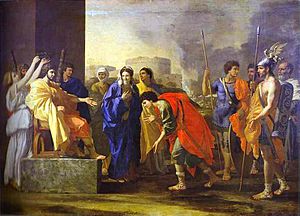
In 211 BC, Scipio's father and uncle were both killed in Spain. They were fighting against Hasdrubal Barca, Hannibal's brother. Rome needed a new general for Spain. Scipio, who was only 25 years old, was the only one brave enough to take the job. Everyone was impressed by his courage and elected him.
When Scipio arrived in Spain, Carthage controlled most of the southern part. Hannibal's brothers, Hasdrubal and Mago, were leading the Carthaginian forces. But they often disagreed, which helped Rome.
Scipio quickly captured Carthago Nova (New Carthage). This was the main Carthaginian base in Spain. He found many supplies and gained a great harbor. Scipio treated prisoners and hostages kindly. This made the local people see Romans as helpers, not just conquerors.
A famous story tells how Scipio's soldiers captured a beautiful young woman. They offered her to Scipio as a prize. But Scipio learned she was engaged to a local leader named Allucius. He returned her to her fiancé, along with money her parents had offered for her release. This kind act made many local tribes support Rome. Allucius himself brought his tribe to join Scipio's army.
In 208 BC, Scipio fought Hasdrubal Barca at Baecula. Scipio won this battle, but Hasdrubal managed to escape and march towards Italy. Many historians wonder why Scipio didn't chase him. One reason might be that Scipio didn't want to risk being trapped by other Carthaginian armies.
After gaining more support from Spanish chiefs, Scipio won a major victory in 206 BC at Ilipa. This battle forced the Carthaginians to leave Spain completely.
After his success in Spain, Scipio visited the Numidian princes Syphax and Massinissa in North Africa. Numidia was important to Carthage because it provided many skilled horsemen for their army. Scipio wanted their support. He managed to get help from both Syphax and Massinissa. However, Syphax later changed his mind and joined Carthage.
Around 206 BC, Scipio founded a Roman settlement called Italica in southern Spain. It later became the birthplace of Roman Emperors Trajan and Hadrian.
Campaign in Africa
In 205 BC, Scipio was elected consul when he was 31. He wanted to take the war to Africa, to attack Carthage directly. But some Roman senators were jealous and didn't give him extra troops. Despite this, Scipio gathered his own volunteers and resources from friends and supporters. He managed to build a force of 30 warships and 7,000 men.
The soldiers in Sicily included many who had survived Roman defeats. Scipio knew they were brave and skilled. He trained his army in Sicily, making them ready for the invasion. Scipio also knew that Carthage had strong cavalry from Numidia. He found a clever way to get more cavalry for his army. He made wealthy Sicilians pay for horses and riders for the Roman army. This helped him build a strong cavalry force.
The Roman Senate sent a group to check on Scipio in Sicily. They found he had a well-trained army and fleet. Scipio asked for permission to go to Africa. Some senators, like Quintus Fabius Maximus Verrucosus, were against it. They still feared Hannibal and thought attacking Africa was too risky. Scipio only got permission to cross to Africa if it seemed good for Rome, but no extra money or soldiers.
With permission, Scipio sailed in 204 BC and landed near Utica. Carthage had allied with the Numidian king Syphax. Their combined forces made Scipio stop his siege of Utica. In 203 BC, Scipio used a clever trick. He secretly approached the Carthaginian and Numidian camps and set them on fire. The enemy armies panicked and fled, and many were killed by Scipio's army. This attack greatly weakened Carthage and took Syphax out of the war.
Scipio then sent his officers to chase Syphax. They defeated him and made Prince Massinissa the new King of Numidia. This was a huge win for Rome. Carthage and Hannibal had always relied on the Numidian cavalry. Now, these excellent horsemen would fight for Rome.
The Battle of Zama
With its allies gone, Carthage tried to make peace. But then Hannibal and his army were called back from Italy. Carthage stopped talking about peace and got ready for war again. Hannibal had about 40,000 soldiers, including 80 war elephants. Scipio had about 29,000 soldiers and 6,100 cavalry.
The two generals met on a plain near Zama on October 19, 202 BC. This was the final Battle of Zama. They respected each other, but peace talks failed. Rome didn't trust Carthage because of past actions.
Hannibal arranged his soldiers in three lines. He planned for his war elephants to charge first, breaking the Roman lines. Then his infantry would attack, supported by cavalry.
Scipio had a smart plan for the elephants. Instead of lining up his soldiers in solid blocks, he arranged them in columns with gaps. When the elephants charged, they ran into traps. Roman trumpets also scared many of them. Many elephants ran harmlessly through the gaps in the Roman lines. Some even turned back and charged into their own army.
The Roman and Numidian cavalry, led by Gaius Laelius and Massinissa, drove off the Carthaginian cavalry. This left the main armies to fight. The battle was fierce. The Roman soldiers pushed back Hannibal's first two lines. Then, Scipio changed his army's formation to one long line to match Hannibal's veterans. The final fight was very tough. But then, the Roman and allied cavalry returned. They charged Hannibal's army from behind. This attack broke Hannibal's forces and gave Rome the victory.
Many Romans wanted Scipio to completely destroy Carthage after his win. But Scipio offered fair peace terms. Carthage had to give up its fleet and pay a tribute. But the terms were light enough for Carthage to recover. With Scipio's agreement, Hannibal was even allowed to become a leader in Carthage.
Coming Home to Rome
Scipio returned to Rome as a hero. He was given a special name, Africanus, to honor his victory in Africa. He refused many other honors, like being consul for life or dictator. In 199 BC, Scipio was elected Censor. For some years after that, he lived quietly and stayed out of politics.
In 190 BC, Rome went to war against Antiochus III of Syria. Scipio joined his brother Lucius Cornelius Scipio Asiaticus in this war. The brothers won a major victory at Magnesia, ending the war.
Later Years and Retirement
Scipio had political enemies, especially Cato the Elder. When Scipio and his brother returned to Rome, his brother faced accusations about money received from Antiochus. Scipio defended his brother. He reminded the people of his great victory at Zama. This caused a huge cheer for him. People followed him to the Capitol, thanking the gods for Scipio.
Despite this support, there were more attempts to bring Scipio to trial. But his future son-in-law, Tiberius Sempronius Gracchus, helped him. Scipio then promised his youngest daughter, Cornelia, to Gracchus.
Scipio retired to his home in Liternum. He lived there for the rest of his life. He tried to help his old rival Hannibal, who was living in exile. Scipio probably died in 183 BC, when he was about 53 years old.
He is said to have asked to be buried away from Rome, because he felt the city had been ungrateful. It is said he wanted this inscription on his tomb: Ingrata patria, ne ossa quidem habebis ("ungrateful fatherland, you will not even have my bones").
It's interesting that his great rival, Hannibal, also died in exile around the same year.
Family Life
Scipio had a happy marriage with his wife, Aemilia Tertia. She was the daughter of Lucius Aemilius Paullus, who died at Cannae. Aemilia was a very independent and wealthy woman. She was a role model for many Roman women. Their youngest daughter, Cornelia, also became a very important role model.
Scipio Africanus had two sons. His elder son, Publius Cornelius Scipio, became a priest but never held a political office due to poor health. His younger son, Lucius Cornelius Scipio, became a praetor. Scipio's elder son adopted his cousin, who became Publius Cornelius Scipio Aemilianus. This adopted grandson also became a famous general.
Scipio and Aemilia also had two daughters who survived. The elder daughter, Cornelia, married her cousin Publius Cornelius Scipio Nasica Corculum. He was also a distinguished Roman leader.
The younger daughter, also named Cornelia, became very famous. She married Tiberius Sempronius Gracchus. They had 12 children, but only three survived. Their two sons, Tiberius Gracchus and Gaius Gracchus, became famous for trying to help the common people of Rome.
Where Scipio is Buried
We don't know for sure where Scipio Africanus is buried. The Tomb of the Scipios has been found in Rome, and you can visit it. But most people believe Scipio Africanus was not buried there. It's possible he was buried at his home in Liternum, as he wished. The writer Livy visited his tomb there many years later.
Some old stories say his ashes were placed in a pyramid in Rome for a while. But it's not certain.
How Romans Saw Scipio
Scipio was a very smart and cultured man. He could speak and read Greek. He even wrote his own memoirs in Greek. He was also known for starting the fashion of Romans shaving their faces, like Alexander the Great. This style lasted for a long time.
He was also a good speaker. People believed he was special and even communicated with the gods. He often visited the temple of Jupiter and made offerings. It's possible he believed this himself.
To his political rivals, Scipio could be harsh. But to others, he was kind and understanding. His love for Greek culture and his different way of wearing the Roman toga caused some disagreement among senators. Cato the Elder felt that Greek influence was harming Roman traditions.
Scipio was a spiritual man, and also a priest of Mars. Some believed he had "second sight" and could see the future in dreams. The historian Polybius thought Scipio's success came from his good planning and intelligence, which he saw as a sign of the gods' favor.
Scipio's Legacy
Military Achievements
Many people consider Scipio to be one of Rome's greatest generals. He never lost a battle. He was skilled in planning battles and in leading his soldiers. He also had a way of making his soldiers feel confident.
The historian Livy tells a story about Scipio meeting the exiled Hannibal. Scipio asked Hannibal who he thought was the greatest commander. Hannibal named Alexander the Great first and Pyrrhus second. When Scipio asked who was third, Hannibal replied, "Myself." Scipio then asked, "What if you had defeated me?" Hannibal cleverly replied, "In that case, I should say that I surpassed Alexander and Pyrrhus, and all other commanders in the world." Scipio was pleased by this answer, as Hannibal had placed him above all other generals.
Political Influence
Scipio was the first Roman general to expand Roman lands outside of Italy and its nearby islands. He conquered Carthaginian territory in Spain for Rome. His victory over Hannibal at Zama led to Carthage's eventual destruction many years later.
His interest in Greek culture had a big impact on wealthy Romans. He didn't introduce Greek ideas, but his strong support for the Greek way of life, combined with his charm, had a lasting effect.
Scipio supported giving land to his veteran soldiers. This was a tradition from the early days of the Roman Republic. His actions might have set an example for later generals like Gaius Marius and Julius Caesar. However, unlike them, Scipio did not try to use his fame to weaken the Roman Republic. He refused to become consul for life or dictator. For putting the good of Rome before his own power, Scipio was praised by Livy for his great mind.
Scipio's relatives continued to be important in Rome for a few generations. His grandsons, the Gracchi brothers, tried to redistribute land to help common Roman citizens. They were killed by other relatives who disagreed with their methods.
In Books and Art
Scipio appears or is mentioned in many famous works. He is in Cicero's writings and in Silius Italicus' epic poem Punica. He is also shown in a vision in Book VI of the Aeneid.
In the Middle Ages, Dante mentions Scipio four times in his Divine Comedy.
During the Renaissance, Scipio was the hero of Petrarch's Latin poem Africa. Machiavelli mentions him in The Prince. Milton also mentions Scipio in Paradise Lost and Paradise Regained. Raphael's painting Vision of a Knight is thought to show Scipio.
Music and Film
Scipio was the main character in several Italian operas during the Baroque period. These included operas by George Frideric Handel and Leonardo Vinci. The march from Handel's opera, Scipione, is still the slow march of the British Grenadier Guards. Scipio is also mentioned in the Italian national anthem.
In film, Benito Mussolini ordered an epic movie about Scipio called Scipione l'africano in 1937. In 1971, a satirical movie called Scipione, detto anche l'Africano was made.
In the 2000 film Gladiator, the first battle in the Colosseum is a re-enactment of Scipio Africanus's battle of Zama. In the 2006 TV film Hannibal, Scipio is played by Shaun Dingwall.
Scipio also appears as a character in several video games, including Age of Empires: The Rise of Rome and Total War: Rome II.
Images for kids
-
A Carthaginian coin depicting Hasdrubal Barca, one of Hannibal's younger brothers.
-
In this painting by Tiepolo, Scipio Africanus is shown releasing the nephew of the Prince of Numidia after he was captured by Roman soldiers. The Walters Art Museum.
-
Portrait of Scipio Africanus, marble, c. 1460–1465, by Mino da Fiesole (Philadelphia Museum of Art).
See also
 In Spanish: Escipión el Africano para niños
In Spanish: Escipión el Africano para niños
- Scipio–Paullus–Gracchus family tree


